Vanuatu cyclone: First aid reaches islands ravaged by Pam
- Published
The President of Vanuatu, Baldwin Lonsdale, described Cyclone Pam as "a monster"
Aid is beginning to arrive in Vanuatu after the Pacific island nation was hit by a cyclone which President Baldwin Lonsdale described as a "monster".
Air force planes arrived with supplies from Australia and New Zealand, and other countries have pledged to help.
Aerial images of the capital Port Vila show many houses completely flattened.
A communications blackout means little is known about conditions beyond the capital but a pilot saw similar devastation in outlying islands.
His voice breaking, President Lonsdale told the BBC that Cyclone Pam had destroyed most buildings in Port Vila, including schools and clinics.
A state of emergency has been declared in the tiny state of 267,000 people, spread over 65 islands.
British doctor Carina Smith describes how healthcare facilities have been damaged
At least eight people are confirmed to have died, but the death toll is expected to rise sharply as rescuers reach outlying islands.
Aid from Australia and New Zealand has begun to reach the island. Australia has pledged A$5 million (£2.5m; $3.8m) in assistance and the UK has pledged £2 million (A$3.9m; $2.9m).
France, UN and European Union have also promised help.
The category five storm, with winds of up to 300km/h (185mph), veered off its expected course and struck populated areas when it reached Vanuatu early on Saturday local time (+11 GMT).
It is now moving towards New Zealand, and though it has weakened, severe weather warnings have been issued for parts of the country.
'Moments of terror'
Port Vila's airport was damaged in the cyclone and was closed to commercial flights until Monday, but the first planes carrying aid supplies were able to land on Sunday, Paolo Malatu, co-ordinator for the National Disaster Management Office, told AP news agency.
He said officials were planning to fly out to outlying islands on Monday to assess the damage.

Aerial image taken by Care Australia's Tom Perry as he flew into Port Vila shows flattened houses
"The wind was [so] strong that the shutters of the window broke off and... the glass windows smashed on the floor," allowing the rain to pour in, a Port Vila resident identified as Jayleen told AP.
President Lonsdale was on Sunday said to be trying to return home from a disaster risk conference he had been attending in Japan when the cyclone hit.
He made an impassioned plea for international help.
"I am speaking to you today with a heart that is so heavy," he said.
"I stand to appeal on behalf of the government and the people to give a helping hand in this disaster."
The BBC's Chris Buckler: "The true devastation caused by the storm is still to be discovered"
In a statement on Sunday, external, Oxfam Australia said up to 90% of housing in Port Vila had reportedly been seriously damaged.
"This is likely to be one of the worst disasters ever seen in the Pacific," said Oxfam's Colin Collet van Rooyen in Port Vila.
"The scale of humanitarian need will be enormous."
Immediate priorities, he said, were providing shelter, clean water and sanitation.
A UN disaster assessment team is due to arrive in Vanuatu in the coming hours.
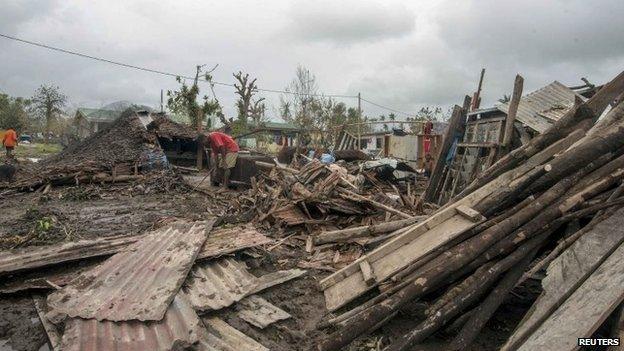
Many houses not built with concrete have been flattened
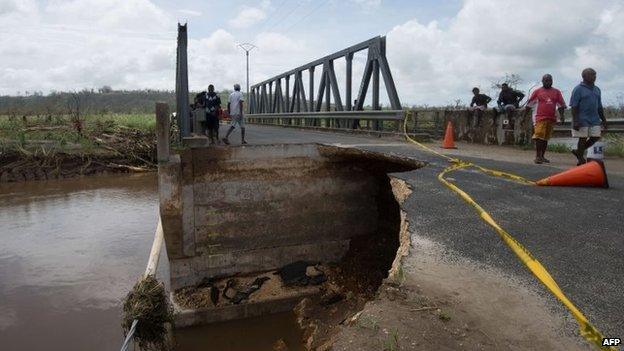
Infrastructure is badly damaged
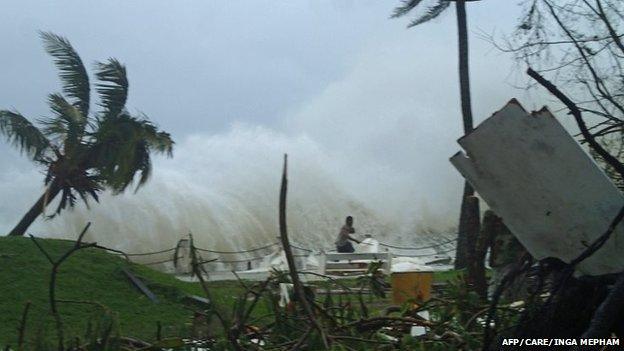
A photo taken on Saturday shows storm waves lashing Port Vila's coastline
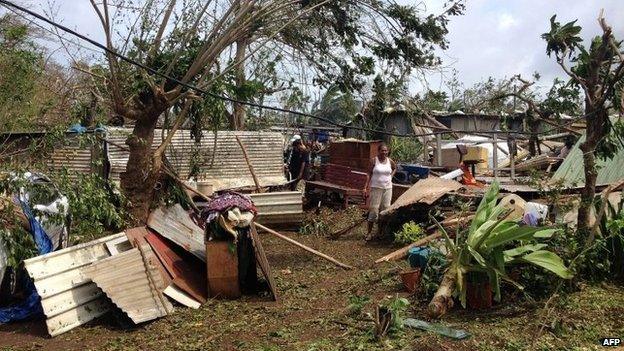
Many residents who survived the storm will find they have little left
"It's devastation out there," said Carina Smith, a British doctor on holiday in Vanuatu at the time the cyclone struck.
"Buildings, trees, power lines are down. Water isn't running clean from taps any more so there's a concern about contamination," she told the BBC.
There was "severe damage" to the hospital in Port Vila, she added.
Pam, one of the most powerful storms in history, is now close to north-east New Zealand having battered the South Pacific island of Vanuatu. Philip Avery reports.
Unconfirmed reports on Saturday said 44 people had died in Penama province in the north-east of Vanuatu, according to the UN's Office for the Co-ordination for Humanitarian Assistance (UNOCHA).
Pam had already caused major damage on other Pacific islands, including Kiribati and the Solomon Islands.
Tuvalu, a group of nine tiny islands north-east of Vanuatu, also declared a state of emergency after the cyclone caused flash floods there.
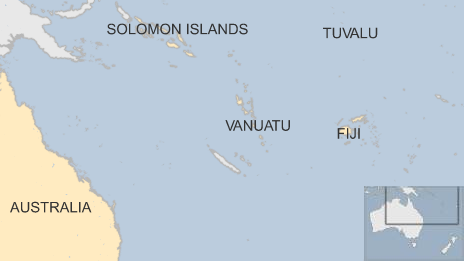
- Published15 March 2015

- Published15 March 2015

- Published27 October 2023
